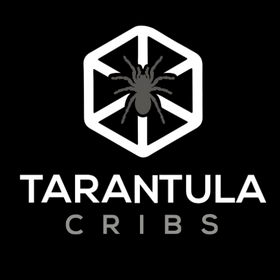Poecilotheria Metallica | Gooty Sapphire Ornamental | Tarantula Care Guide
Common Name: Gooty Sapphire Ornamental
Scientific Name: Poecilotheria metallica
Lifespan: 12-15 years (females), 3-5 years (males)
Size: 6-8 inches (leg span)
This species is highly prized due to its stunning blue coloration and distinct yellow markings. However, due to their speed, defensive nature, and venom potency, Poecilotheria metallica is recommended for intermediate to advanced keepers.
Housing
- Enclosure Size: Arboreal tarantulas require vertical space, so a tall enclosure (at least 12-18 inches tall) is ideal for an adult. A 10-gallon tank works well, or a specialized vertical terrarium. We recommend our Arboreal enclosures for the best care.
- Substrate: 2-3 inches of coco fiber, peat moss, or topsoil at the bottom. Even though they are arboreal, a bit of substrate for moisture retention is necessary. We recommend our Aracnidirt.
- Climbing Structures: Provide plenty of vertical hiding places like cork bark, branches, or fake plants. They will spin webs high in the enclosure.
- Hide: Hollowed-out logs or large pieces of cork bark make excellent hides.
- Ventilation: Good airflow is essential to prevent mold, but avoid drafts. Use a screen lid or ensure well-placed ventilation holes.
Temperature and Humidity
- Temperature: 75-85°F (24-29°C). While they tolerate room temperatures, keeping them in the higher range ensures better growth and activity.
- Humidity: 65-75%. Mist the enclosure lightly every few days to maintain humidity levels. Ensure the substrate stays slightly moist, but not overly wet.
- Water Dish: A small, shallow water dish should always be provided.
Diet
- Food: Feed them gut-loaded crickets, roaches, or other insects. Adults should be fed every 7-10 days, while juveniles can be fed more frequently, every 5-7 days.
- Size of Prey: Prey should be appropriately sized — no larger than the tarantula’s abdomen.
- Feeding Notes: They are fast eaters. Remove uneaten prey after 24 hours.
Temperament/Personality
- Behavior: Poecilotheria metallica is fast and can be defensive, so it's not a species recommended for handling. They are more prone to running or hiding than attacking but will bite if threatened.
- Handling: Not recommended due to their speed and potent venom. While not lethal to humans, a bite can cause significant pain and other symptoms.
Molting
- Signs of Molting: They will stop eating for several days or even weeks prior to molting. Juveniles molt more frequently, while adults molt annually or less often.
- After Molting: Wait at least a week before offering food, ensuring their new exoskeleton has hardened.
Cleaning and Maintenance
- Spot Clean: Regularly remove waste and uneaten prey to prevent mold or mites.
- Full Cleaning: Complete enclosure clean-ups are needed less frequently, perhaps once a year or when the enclosure gets too damp or dirty.
General Notes
- Webbing: Poecilotheria metallica spins intricate webs in the upper parts of their enclosure, often surrounding their chosen hide.
- Lighting: No special lighting is needed. Avoid direct sunlight or intense heat, as it can stress the tarantula.
- Activity: They are mainly nocturnal, though you might see them hunting or webbing during the day. They are quite skittish and will retreat quickly into their hide when disturbed.
Where to find this tarantula?
- Coming soon


